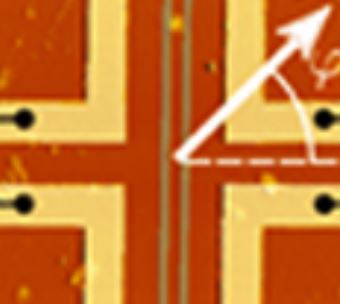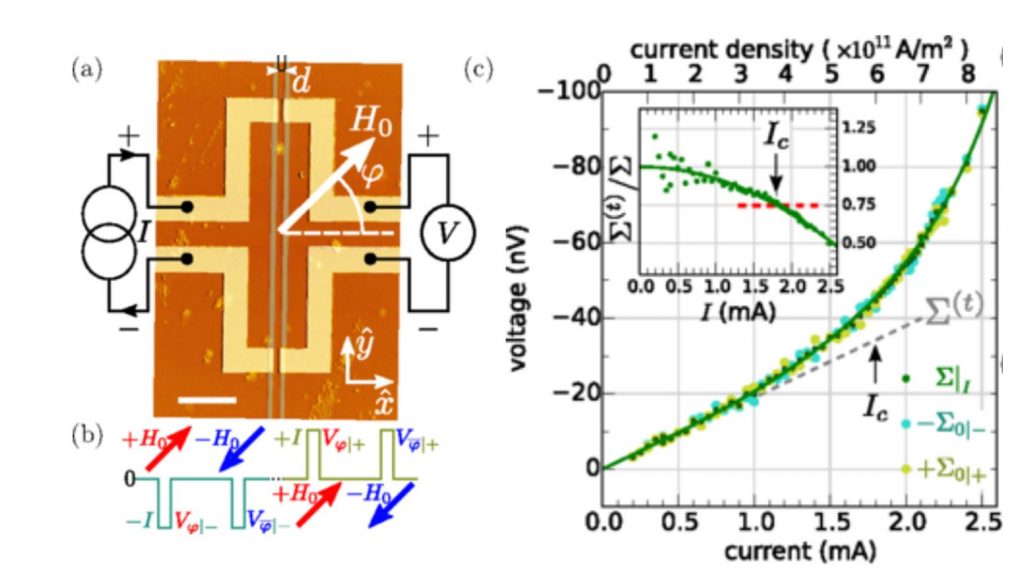
The recent demonstrations that spin-orbit torques (SOTs) allow one to generate and detect pure spin currents transfers to an adjacent layer has radically changed our grasp about material compatibility with spintronics. In particular, it has triggered a renewed interest in magnetic insulators, which are much better spin conductors than metals. A large effort has concentrated so far on yttrium iron garnet (YIG), which is famous for having the lowest known magnetic damping parameter. The typical experiment is a non-local transport measurement between two parallel Pt wires deposited on top of YIG as illustrated .
In a recent joint paper publication, we have reported measurement of the non-local spin conductance of YIG films when the driving current is varied in a wide magnitude range creating, first, a quasi-equilibrium transport regime and, then, driving the system to a strongly out-of-equilibrium state. The lateral device is biased by an in-plane magnetic field set at a variable azimuthal angle φ. We sort the nonlocal voltages according to their symmetry with respect to the magnetization direction. At low current, the spin transfer signal, Σ0, follows first a linear behavior which is believed to be dominated by thermal magnons’ transport. The interesting novel feature is the fact that the signal, Σ0, deviates from a purely linear transport behavior at large current above, Ic. Quite remarkably the deviation from the linear conductance occurs very gradually and approximately follows a quadratic behavior (see insert). We have also found that at high current, the spin conductance is dominated by magnetostatic magnons, which are low-damping non-equilibrium magnons thermalized near the spectral bottom by magnon-magnon interaction, with consequent a sensitivity to the applied magnetic field. These findings are not only important from the fundamental point of view, but might be also useful for future applications. Although transport of thermal magnons is difficult to control due to their relatively high energies, the crossover to a subthermal spin conduction regime allows the development of controllable spin conductors by relatively weak magnetic fields. From a fundamental point of view, these studies of magnon transport in YIG by means of the direct and inverse spin Hall effects are also very interesting as they provide new means to alter strongly the energy distribution of magnons up to thermal energies, where the interplay between these nonequilibrium populations is expected to lead to new collective quantum phenomena at room temperature.

Contact CEA-IRAMIS : Grégoire de Loubens et Michel Viret (CEA-IRAMIS/SPEC/LNO).
Contact CEA-INAC – SPINTEC : Olivier Klein.
Collaboration:
- 1SPINTEC and CEA/DRF/INAC Team: Microwave / RF, CEA-Grenoble, CNRS, Université Grenoble Alpes, 38054 Grenoble, France
- 2Institute of Physics, Kazan Federal University, Kazan 420008, Russian Federation
- 3SPEC, CEA-Saclay, CNRS, Université Paris-Saclay, 91191 Gif-sur-Yvette, France
- 4LabSTICC, CNRS, Université de Bretagne Occidentale, 29238 Brest, France
- 5Department of Physics, University of Muenster, 48149 Muenster, Germany
- 6Institute of Metal Physics, Ural Division of RAS, Yekaterinburg 620041, Russian Federation
- 7Department of Physics, Oakland University, Michigan 48309, USA
- 8Unité Mixte de Physique CNRS, Thales, Université Paris-Saclay, 91767 Palaiseau, France
References:
1) Nonlinear spin conductance of yttrium iron garnet thin films driven by large spin-orbit torque,
N. Thiery, A. Draveny, V. V. Naletov, L. Vila, J. P. Attané, C. Beigné, G. de Loubens, M. Viret, N. Beaulieu, J. Ben Youssef, V. E. Demidov, S. O. Demokritov, A. N. Slavin, V. S. Tiberkevich, A. Anane, P. Bortolotti, V. Cros, and O. Klein, Phys. Rev. B 97, 060409 (2018).
2) Electrical properties of epitaxial yttrium iron garnet ultrathin films at high temperatures,
N. Thiery, V. V. Naletov, L. Vila, A. Marty, A. Brenac, J.-F. Jacquot, G. de Loubens, M. Viret, A. Anane, V. Cros, J. Ben Youssef, N. Beaulieu, V. E. Demidov, B.
Divinskiy, S. O. Demokritov, and O. Klein, Phys. Rev. B 97, 064422 (2018).




